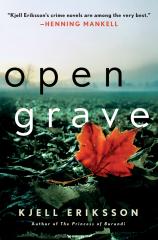Open Grave
Review
Open Grave
If you have not previously read one of Kjell Eriksson’s Ann Lindell novels, it’s best not to enter your inaugural experience with preconceived expectations concerning what he defines as a “mystery” novel. This is particularly true of OPEN GRAVE, newly released --- thanks to the yeoman efforts of translator Paul Norlen --- in the United States in 2015 (and first published in Sweden in 2009). To say that Eriksson proceeds at his own pace is to understate the obvious. Things move, shall we say, sedately for the first third of the book, with only a bump or two encountered by the midway point, before things pick up a bit in the second half. I’m not being critical here, because what we are witnessing is the way that Eriksson fails to follow the classic mystery formula. He tears it up, stomps on it and kicks dirt all over it, all while making it work in the bargain.
"I never saw the ending coming, not even on the next-to-last page. Actually, I may not have seen it on the last page either. This may be the most subtle mystery you’ll read this year, not to mention one of the best."
The propelling motivator (if that is the right word) of OPEN GRAVE is the announcement of the award of the Nobel Prize for medicine to Professor Bertram von Ohler, a now-retired researcher in his late 80s. The news sets off a firestorm of criticism and controversy around the world and, interestingly enough, in von Ohler’s own neighborhood. Associate Professor Gregor Johansson, who lives just a couple of doors away from von Ohler, is less than pleased with the news, not so much due to von Ohler’s award but because of his own exclusion, given that he was a member of the team that some decades before made the discovery for which von Ohler is now getting recognition. That von Ohler, in his initial statement to the press, noted the contributions of Johansson and others just doesn’t seem to be enough.
An aside here: Eriksson does an excellent job of explaining the somewhat disorderly manner in which credit is allotted with respect to scientific research without getting bogged down in the minute details. As has been noted elsewhere, those who enjoy sausage should never watch it being made. The controversy, in any event, goes up a notch or two when someone first hurls a rock at von Ohler’s roof, after which a human skull is found in his mailbox. Eriksson makes us privy to the knowledge of the rock thrower’s identity --- a man who has been hired by von Ohler’s neighbor as a gardener and has his own agenda --- but not the skull mailer.
Police inspector Ann Lindell is tasked with taking a report, and the matter seemingly ends when she is called to the scene of an obvious murder-suicide involving a married couple. Oh, and there is an extremelyinteresting tie-in between a member of von Ohler’s household and Lindell’s own past. There is also a bit of a domestic drama taking place in von Ohler’s household. His housekeeper of over 50 years is the youngest of three sisters so tasked for the duty, and there is some unstated tension between herself and the master of the house. There is quite a history there, and we learn all too soon --- in dribs and drabs, bits and pieces --- that taking credit where credit is not due is hardly the worst of the elderly professor’s sins. Whether he and others will experience justice for his wrongdoings is another story. You’ll have to read OPEN GRAVE to find out what that story is.
The plot structure may appear to be a hodgepodge, but it’s not. I never saw the ending coming, not even on the next-to-last page. Actually, I may not have seen it on the last page either. This may be the most subtle mystery you’ll read this year, not to mention one of the best. See if you agree.
Reviewed by Joe Hartlaub on August 7, 2015





